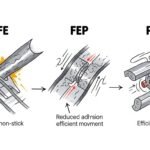Introduction
Polytetrafluoroethylene (PTFE) sheets are fundamental semi-finished products used across numerous industries for applications ranging from chemical linings and gaskets to electrical insulation and food processing surfaces. However, not all PTFE sheets are created equal. They are manufactured using different processes – primarily compression molding and skiving – which result in distinct material properties, performance characteristics, and ideal applications. Understanding the differences between skived PTFE sheets and molded PTFE sheets is crucial for selecting the right material for your specific needs. This article provides a detailed comparison to help engineers and buyers make informed decisions.
Manufacturing Processes
Molded PTFE Sheets
- Process: PTFE powder is compressed into a mold cavity under high pressure and then sintered (heated to a temperature just below its melting point) to fuse the particles together.
- Structure: Results in a homogeneous, isotropic material with uniform properties in all directions.
- Density: Typically higher density compared to skived sheets.
Skived PTFE Sheets
- Process: A large PTFE billet (pre-formed and sintered) is sliced into thin layers using a sharp blade, similar to shaving.
- Structure: Creates a material with a directional grain or fiber structure due to the slicing process, resulting in anisotropic properties.
- Density: Generally lower density than molded sheets.
Performance Characteristics Comparison
Physical Properties
| Property | Skived PTFE Sheets | Molded PTFE Sheets |
|---|---|---|
| Density | Lower | Higher |
| Tensile Strength | Directional (higher along the grain) | Uniform, generally higher overall |
| Elongation at Break | Higher in the direction of the grain | More uniform, moderate |
| Flexibility | More flexible, especially in thin gauges | Stiffer, more rigid |
Chemical & Thermal Performance
| Property | Skived PTFE Sheets | Molded PTFE Sheets |
|---|---|---|
| Chemical Resistance | Excellent (virtually identical to molded) | Excellent (industry standard) |
| Temperature Range | -200°C to +260°C (same as molded) | -200°C to +260°C |
| Thermal Expansion | Slightly different due to grain structure | Uniform coefficient of thermal expansion |
Key Decision Factors
When to Choose Skived PTFE Sheets
- Thin Gauges Required: Easier to produce very thin sheets (down to 0.025mm or less).
- Flexibility Needed: Applications requiring conformability or flexibility, such as wrapping or forming.
- Sealing Applications: Gaskets or seals where conformability to flange surfaces is beneficial.
- Low Bolt Load: Situations where lower clamping force is preferred.
- Cost Sensitivity: Often more economical for certain thicknesses and volumes.
When to Choose Molded PTFE Sheets
- High Mechanical Loads: Applications requiring maximum tensile strength and rigidity.
- Dimensional Stability: Critical applications where uniform properties and minimal creep are essential.
- Thick Sections: Required thicknesses where molded sheets are more practical.
- Structural Applications: Parts that must maintain shape and strength under load.
- High-Pressure Applications: Situations where resistance to deformation under pressure is crucial.
Typical Applications
Skived PTFE Sheet Applications
- Gaskets & Seals: Flexible gaskets for flanged joints, especially in chemical processing.
- Tape & Wrap: PTFE tape for thread sealing, protective wraps for cables or pipes.
- Electrical Insulation: Thin, flexible insulating layers in electronic applications.
- Release Films: Non-stick surfaces for manufacturing processes.
- Laboratory Applications: Flexible liners or covers requiring chemical resistance.
Molded PTFE Sheet Applications
- Chemical Linings: Tank linings, chute linings, and structural components requiring high strength.
- Structural Components: Machine parts, wear pads, and insulating barriers needing rigidity.
- High-Pressure Gaskets: Gaskets for high-pressure applications where minimal creep is essential.
- Electrical Insulators: Thick insulating panels or structural electrical components.
- Food Processing Equipment: Durable, non-stick surfaces for processing machinery.

skived ptfe sheets visual check
Quality and Compliance Considerations
- Both Types: Should be manufactured under ISO 9001 certified processes.
- Material Traceability: Full documentation including Certificates of Conformity (CoC) and Material Safety Data Sheets (MSDS).
- Food & Pharma: FDA and USP Class VI compliant grades available for both types.
- Purity: High-purity grades available for semiconductor and critical applications.
Conclusion
The choice between skived PTFE sheets and molded PTFE sheets depends on the specific performance requirements of your application. Skived sheets offer superior flexibility, easier production of thin gauges, and are often more economical for sealing applications where conformability is key. Molded sheets provide better dimensional stability, higher mechanical strength, and are preferred for structural applications or where maximum rigidity is required. Both forms offer the exceptional chemical resistance and thermal stability that make PTFE invaluable across industries. Xiflon supplies both skived and molded PTFE sheets in various thicknesses and grades, ensuring you can access the right form for your needs. Our technical expertise helps guide you to the optimal choice based on your application’s mechanical, thermal, and chemical requirements. Whether you need flexible skived PTFE tape for sealing or rigid molded PTFE sheets for structural components, Xiflon provides high-quality materials with full compliance support (ISO 9001, FDA, REACH, etc.). Contact us for assistance in selecting the best PTFE sheet format for your project.







